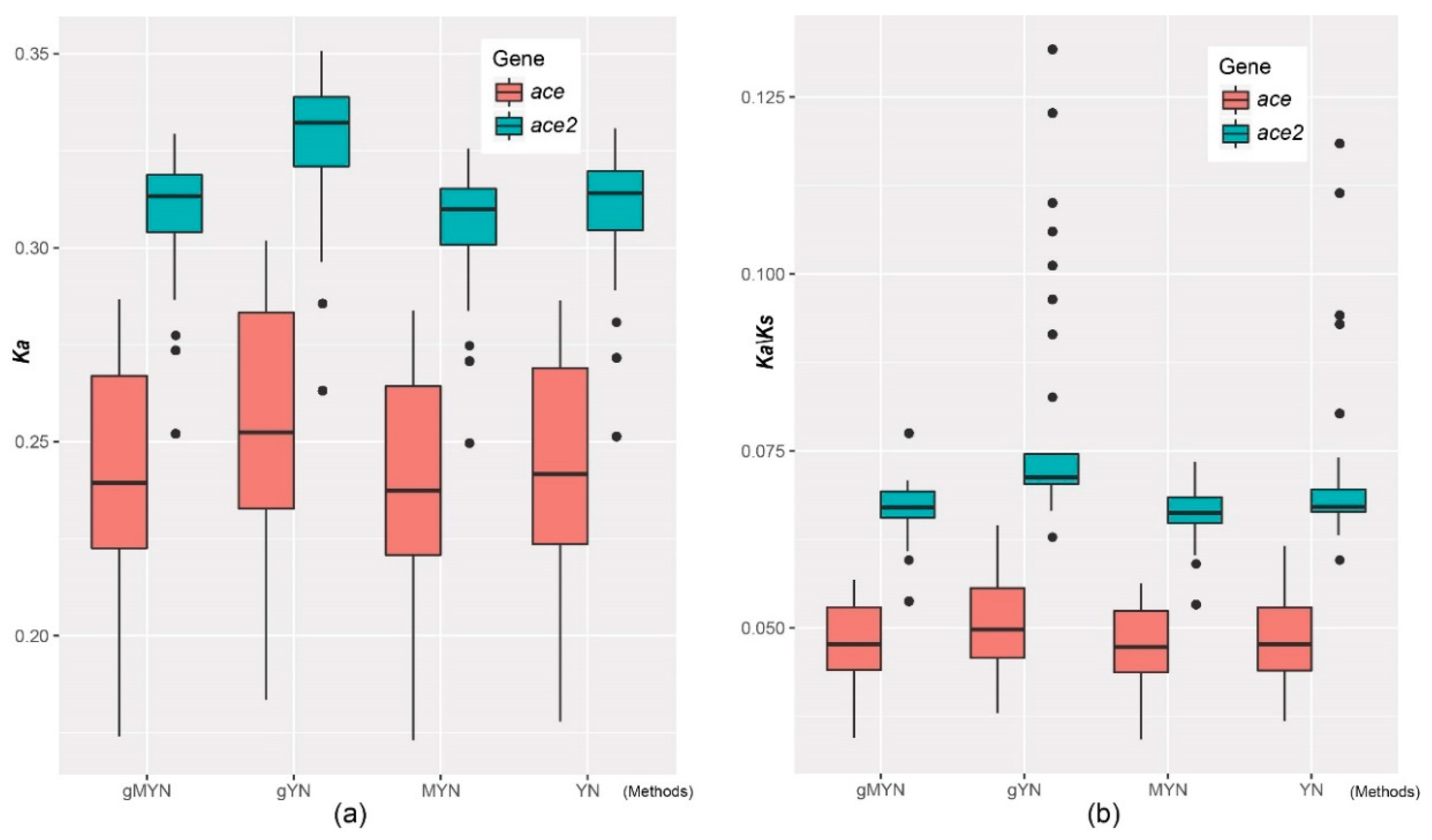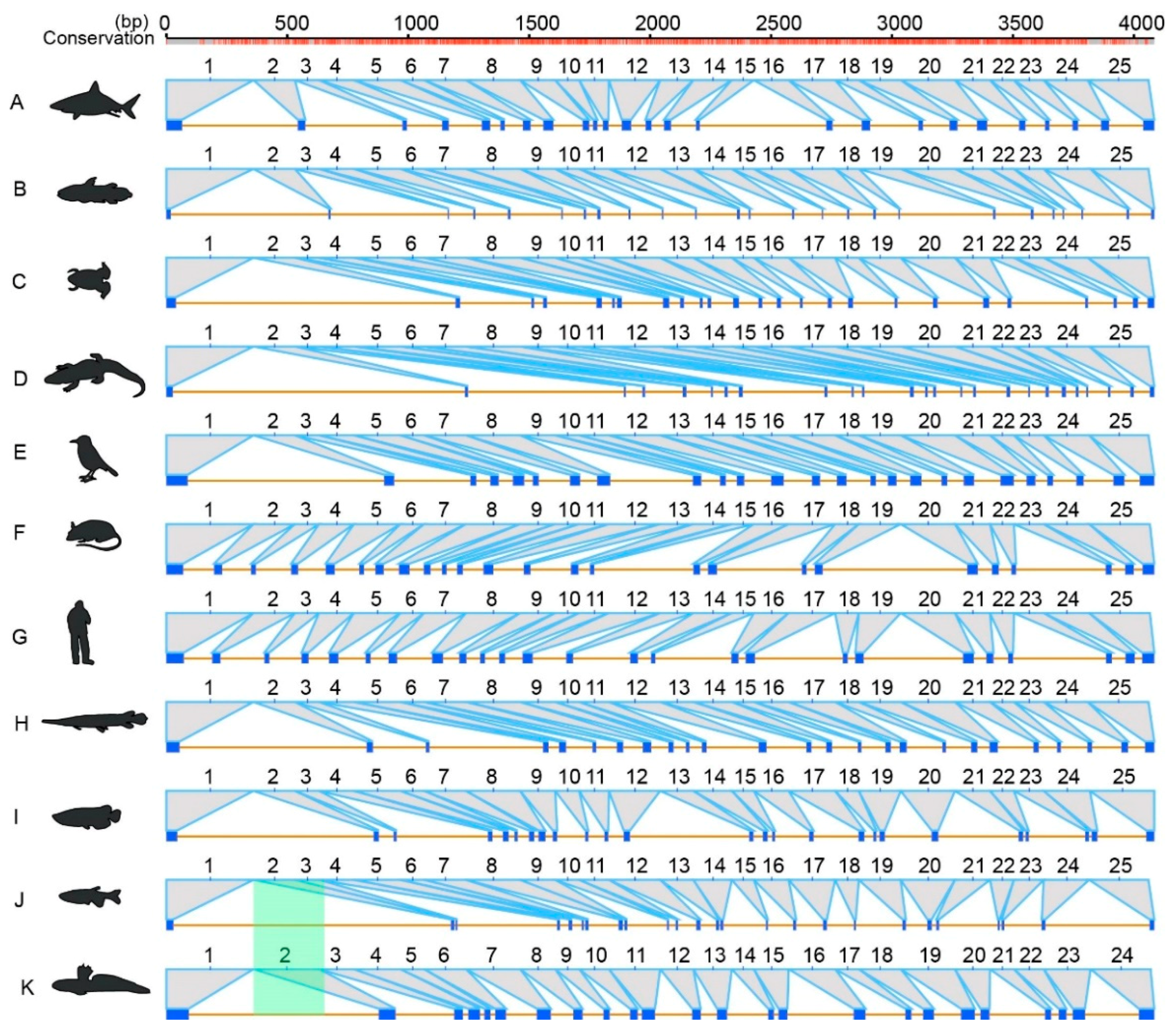A Genomic Survey of Angiotensin-Converting Enzymes Provides Novel Insights into Their Molecular Evolution in Vertebrates
Abstract
1. Introduction
2. Results
2.1. Collection of ace and ace2 Sequences
2.2. Phylogenetic Topologies of ace and ace2 Genes
2.3. Conserved Synteny of ace and ace2 Genes
2.4. Substitution Rate Variations and Gene Structural Changes
2.5. Exon Comparisons and Homologous Region Variations
3. Discussion
3.1. Early Evolution of ace and ace2 Genes in Vertebrates
3.2. Rearrangements of ace and ace2 Adjacent Regions
3.3. Evolution of Homologous Regions between ace and ace2
4. Materials and Methods
4.1. Gene Extraction, Collection and Confirmation
4.2. Conserved Synteny Identification and Phylogenetic Inference
4.3. Substitution Rate Estimation and Comparison
4.4. Examination of Gene Structural Variations
5. Conclusions
Supplementary Materials
Author Contributions
Funding
Acknowledgments
Conflicts of Interest
References
- Cushman, D.W.; Ondetti, M.A. Design of angiotensin converting enzyme inhibitors. Nat. Med. 1999, 5, 1110–1113. [Google Scholar] [CrossRef] [PubMed]
- Sparks, M.A.; Crowley, S.D.; Gurley, S.B.; Mirotsou, M.; Coffman, T.M. Classical renin-angiotensin system in kidney physiology. Compr. Physiol. 2014, 4, 1201–1228. [Google Scholar] [PubMed]
- Chappell, M.C. Biochemical evaluation of the renin-angiotensin system: The good, bad, and absolute? Am. J. Physiol. Heart Circ. Physiol. 2016, 310, 137–152. [Google Scholar] [CrossRef] [PubMed]
- Atlas, S.A. The renin-angiotensin aldosterone system: Pathophysiological role and pharmacologic inhibition. J. Manag. Care Pharm. 2007, 13, 9–20. [Google Scholar] [CrossRef] [PubMed]
- Yim, H.E.; Yoo, K.H. Renin-angiotensin system-considerations for hypertension and kidney. Electrolyte Blood Press 2008, 6, 42–50. [Google Scholar] [CrossRef] [PubMed]
- Ouali, R.; Berthelon, M.C.; Begeot, M.; Saez, J.M. Angiotensin Ii receptor subtypes At1 and At2 are down-regulated by angiotensin Ii through At1 receptor by different mechanisms. Endocrinology 1997, 138, 725–733. [Google Scholar] [CrossRef] [PubMed]
- Corvol, P.; Eyries, M.; Soubrier, F. Peptidyl-dipeptidase A/angiotensin I-converting enzyme. In Handbook of Proteolytic Enzymes (Second Edition); Elsevier: Paris, France, 2004; Volume 1, pp. 332–346. [Google Scholar]
- Riordan, J.F. Angiotensin-I-converting enzyme and its relatives. Genome Biol. 2003, 4, 225. [Google Scholar] [CrossRef] [PubMed][Green Version]
- Fournier, D.; Luft, F.C.; Bader, M.; Ganten, D.; Andrade-Navarro, M.A. Emergence and evolution of the renin–angiotensin–aldosterone system. J. Mol. Med. 2012, 90, 495–508. [Google Scholar] [CrossRef] [PubMed]
- Roca-Ho, H.; Riera, M.; Palau, V.; Pascual, J.; Soler, M.J. Characterization of Ace and Ace2 expression within different organs of the nod mouse. Int. J. Mol. Sci. 2017, 18, 563. [Google Scholar] [CrossRef] [PubMed]
- Xia, H.; Lazartigues, E. Angiotensin-converting enzyme 2 in the brain: Properties and future directions. J. Neurochem. 2008, 107, 1482–1494. [Google Scholar] [CrossRef] [PubMed]
- Tikellis, C.; Thomas, M. Angiotensin-converting enzyme 2 (ACE2) is a key modulator of the renin angiotensin system in health and disease. Int. J. Pept. 2012, 2012, 256–294. [Google Scholar] [CrossRef] [PubMed]
- Yang, J.; Chen, X.; Bai, J.; Fang, D.; Qiu, Y.; Jiang, W.; Yuan, H.; Bian, C.; Lu, J.; He, S. The Sinocyclocheilus cavefish genome provides insights into cave adaptation. BMC Biol. 2016, 14, 1. [Google Scholar] [CrossRef] [PubMed]
- You, X.; Bian, C.; Zan, Q.; Xu, X.; Liu, X.; Chen, J.; Wang, J.; Qiu, Y.; Li, W.; Zhang, X. Mudskipper genomes provide insights into the terrestrial adaptation of amphibious fishes. Nat. Commun. 2014, 5, 5594. [Google Scholar] [CrossRef] [PubMed]
- Amemiya, C.T.; Alfoldi, J.; Lee, A.P.; Fan, S.; Philippe, H.; Maccallum, I.; Braasch, I.; Manousaki, T.; Schneider, I.; Rohner, N. The African coelacanth genome provides insights into tetrapod evolution. Nature 2013, 496, 311–316. [Google Scholar] [CrossRef] [PubMed]
- Braasch, I.; Gehrke, A.R.; Smith, J.J.; Kawasaki, K.; Manousaki, T.; Pasquier, J.; Amores, A.; Desvignes, T.; Batzel, P.; Catchen, J.; et al. The spotted gar genome illuminates vertebrate evolution and facilitates human-teleost comparisons. Nat. Genet. 2016, 48, 427–437. [Google Scholar] [CrossRef] [PubMed]
- Lin, Q.; Fan, S.; Zhang, Y.; Xu, M.; Zhang, H.; Yang, Y.; Lee, A.P.; Woltering, J.M.; Ravi, V.; Gunter, H.M.; et al. The seahorse genome and the evolution of Its specialized morphology. Nature 2016, 540, 395–399. [Google Scholar] [CrossRef] [PubMed]
- Wang, D.P.; Wan, H.L.; Zhang, S.; Yu, J. Gamma-MYN: A new algorithm for estimating Ka and Ks with consideration of variable substitution rates. Biol. Direct. 2009, 4, 20. [Google Scholar] [CrossRef] [PubMed]
- Wang, D.; Zhang, S.; He, F.; Zhu, J.; Hu, S.; Yu, J. How do variable substitution rates influence Ka and Ks calculations? Genom. Proteom. Bioinf. 2009, 7, 116–127. [Google Scholar] [CrossRef]
- Zhang, Z.; Li, J.; Yu, J. Computing Ka and Ks with a consideration of unequal transitional substitutions. BMC Evol. Biol. 2006, 6, 44. [Google Scholar] [CrossRef] [PubMed]
- Yang, Z.H.; Nielsen, R. Estimating synonymous and nonsynonymous substitution rates under realistic evolutionary models. Mol. Biol. Evol. 2000, 17, 32–43. [Google Scholar] [CrossRef] [PubMed]
- Feng, Y.; Xia, H.; Santos, R.A.; Speth, R.; Lazartigues, E. Angiotensin-converting enzyme 2: A new target for neurogenic hypertension. Exp. Physiol. 2010, 95, 601–606. [Google Scholar] [CrossRef] [PubMed]
- Chou, C.-F.; Loh, C.B.; Foo, Y.K.; Shen, S.; Fielding, B.C.; Tan, T.H.; Khan, S.; Wang, Y.; Lim, S.G.; Hong, W. Ace2 orthologues in non-mammalian vertebrates (Danio, Gallus, Fugu, Tetraodon and Xenopus). Gene 2006, 377, 46–55. [Google Scholar] [CrossRef] [PubMed]
- Guyomard, R.; Boussaha, M.; Krieg, F.; Hervet, C.; Quillet, E. A synthetic rainbow trout linkage map provides new insights into the salmonid whole genome duplication and the conservation of synteny among teleosts. BMC Genet. 2012, 13, 15. [Google Scholar] [CrossRef] [PubMed]
- Glasauer, S.M.; Neuhauss, S.C. Whole-genome duplication in teleost fishes and its evolutionary consequences. Mol. Genet. Genomics 2014, 289, 1045–1060. [Google Scholar] [CrossRef] [PubMed]
- Kasahara, M.; Naruse, K.; Sasaki, S.; Nakatani, Y.; Qu, W.; Ahsan, B.; Yamada, T.; Nagayasu, Y.; Doi, K.; Kasai, Y. The medaka draft genome and insights into vertebrate genome evolution. Nature 2007, 447, 714. [Google Scholar] [CrossRef] [PubMed]
- Meyer, A.; Van de Peer, Y. From 2R to 3R: Evidence for a fish-specific genome duplication (FSGD). Bioessays 2005, 27, 937–945. [Google Scholar] [CrossRef] [PubMed]
- Inoue, J.; Sato, Y.; Sinclair, R.; Tsukamoto, K.; Nishida, M. Rapid genome reshaping by multiple-gene loss after whole-genome duplication in teleost fish suggested by mathematical modeling. Proc. Natl. Acad. Sci. USA 2015, 112, 14918–14923. [Google Scholar] [CrossRef] [PubMed]
- Cornell, M.J.; Williams, T.A.; Lamango, N.S.; Coates, D.; Corvol, P.; Soubrier, F.; Hoheisel, J.; Lehrach, H.; Isaac, R.E. Cloning and expression of an evolutionary conserved single-domain angiotensin converting enzyme from drosophila melanogaster. J. Biol. Chem. 1995, 270, 13613–13619. [Google Scholar] [CrossRef] [PubMed]
- Lobo, I. Basic local alignment search tool (Blast). J. Mol. Biol. 2012, 215, 403–410. [Google Scholar]
- Kumar, S.; Stecher, G.; Tamura, K. Mega7: Molecular evolutionary genetics analysis version 7.0 for bigger datasets. Mol. Biol. Evol. 2016, 33, 1870–1874. [Google Scholar] [CrossRef] [PubMed]
- Darriba, D.; Taboada, G.L.; Doallo, R.; Posada, D. Jmodeltest 2: More models, new heuristics and parallel computing. Nat. Methods 2012, 9, 772. [Google Scholar] [CrossRef] [PubMed]
- Ronquist, F.; Teslenko, M.; Van Der Mark, P.; Ayres, D.L.; Darling, A.; Hohna, S.; Larget, B.; Liu, L.; Suchard, M.A.; Huelsenbeck, J.P. Mrbayes 3.2: Efficient bayesian phylogenetic inference and model choice across a large model space. Syst. Biol. 2012, 61, 539–542. [Google Scholar] [CrossRef] [PubMed]
- Drummond, A.J.; Rambaut, A. Beast: Bayesian evolutionary analysis by sampling trees. BMC Evol. Biol. 2007, 7, 214. [Google Scholar] [CrossRef] [PubMed]
- Stamatakis, A. Stamatakis A. RAxML-VI-HPC: Maximum likelihood-based phylogenetic analyses with thousands of taxa and mixed models, v. 7.03. Bioinformation 2006, 22, 2688–2690. [Google Scholar] [CrossRef] [PubMed]
- Posada, D.; Buckley, T.R. Model selection and model averaging in phylogenetics: Advantages of akaike information criterion and bayesian approaches over likelihood ratio tests. Syst. Biol. 2004, 53, 793–808. [Google Scholar] [CrossRef] [PubMed]
- Darriba, D.; Taboada, G.L.; Doallo, R.; Posada, D. ProtTest 3: Fast selection of best-fit models of protein evolution. Bioinformatics 2011, 27, 1164–1165. [Google Scholar] [CrossRef] [PubMed]
- Guindon, S.; Dufayard, J.F.; Lefort, V.; Anisimova, M.; Hordijk, W.; Gascuel, O. New algorithms and methods to estimate maximum-likelihood phylogenies: Assessing the performance of PhyML 3.0. Syst. Biol. 2010, 59, 307–321. [Google Scholar] [CrossRef] [PubMed]
- Zhang, Z.; Li, J.; Zhao, X.Q.; Wang, J.; Wong, G.K.S.; Yu, J. Kaks_calculator: Calculating Ka and Ks through model selection and model averaging. Genom. Proteom. Bioinf. 2006, 4, 259–263. [Google Scholar] [CrossRef]
- R Development Core Team. R: A Language and Environment for Statistical Computing; The R Foundation for Statistical Computing: Vienna, Austria, 2013. [Google Scholar]
- Kapustin, Y.; Souvorov, A.; Tatusova, T.; Lipman, D. Splign: Algorithms for computing spliced alignments with identification of paralogs. Biol. Direct. 2008, 3, 20. [Google Scholar] [CrossRef] [PubMed]







| Class | Common Name | Species Name | GenBank ID |
|---|---|---|---|
| Chondrichthyes | Elephant shark | Callorhynchus milii | GCA_000165045.2 |
| Sarcopterygii | Coelacanth | Latimeria chalumnae | GCF_000225785.1 |
| Amphibians | Tropical clawed frog | Xenopus tropicalis | GCA_000004195.3 |
| Aves | Golden-collared manakin | Manacus vitellinus | GCA_001715985.2 |
| Tibetan ground-tit | Pseudopodoces humilis | GCA_000331425.1 | |
| Reptiles | American alligator | Alligator mississippiensis | GCF_000281125.3 |
| Gekko | Gekko japonicus | GCA_001447785.1 | |
| Green anole | Anolis carolinensis | GCA_000090745.2 | |
| Python bivittatus | Python bivittatus | GCA_000186305.2 | |
| Mammals | House mouse | Mus musculus | GCF_000001635.25 |
| Norway rat | Rattus norvegicus | GCF_000001895.5 | |
| Yangtze River dolphin | Lipotes vexillifer | GCA_000442215.1 | |
| Killer whale | Orcinus orca | GCA_000331955.2 | |
| Crab eating macaque | Macaca fascicularis | GCF_000364345.1 | |
| Human | Homo sapiens | GCF_000001405.37 | |
| Actinopterygii | Spotter gar | Lepisosteus oculatus | GCF_000242695.1 |
| Asian arowana | Scleropages formosus | GCF_001624265.1 | |
| Zebrafish | Danio rerio | GCF_000002035.4 | |
| Chinese golden-line fish (Sa) | Sinocyclocheilus anshuiensis | GCF_001515605.1 | |
| Channel catfish | Ictalurus punctatus | GCF_001660625.1 | |
| Mexican tetra | Astyanax mexicanus | GCF_000372685.1 | |
| Red-bellied piranha | Pygocentrus nattereri | GCF_001682695.1 | |
| Northern pike | Esox lucius | GCA_000721915.3 | |
| Rainbow trout | Oncorhynchus mykiss | GCF_002163495.1 | |
| Blue-spotted mudskipper (Bp) | Boleophthalmus pectinirostris | GCF_000788275.1 | |
| Tiger seahorse | Hippocampus comes | GCF_001891065.1 | |
| Mummichog | Fundulus heteroclitus | GCA_000826765.1 | |
| Amazon molly | Poecilia formosa | GCA_000485575.1 | |
| Sailfin molly | Poecilia latipinna | GCA_001443285.1 | |
| Tongue sole | Cynoglossus semilaevis | GCF_000523025.1 | |
| Barramundi perch | Lates calcarifer | GCF_001640805.1 | |
| Large yellow croaker | Larimichthys crocea | GCF_000972845.1 | |
| Tilapia | Oreochromis niloticus | GCF_001858045.1 | |
| African cichlid | Neolamprologus brichardi | GCF_000239395.1 | |
| Burton mouth brooder | Haplochromis burtoni | GCF_000239415.1 | |
| Nyerrrei cichlid | Pundamilia nyererei | GCF_000239375.1 |
© 2018 by the authors. Licensee MDPI, Basel, Switzerland. This article is an open access article distributed under the terms and conditions of the Creative Commons Attribution (CC BY) license (http://creativecommons.org/licenses/by/4.0/).
Share and Cite
Lv, Y.; Li, Y.; Yi, Y.; Zhang, L.; Shi, Q.; Yang, J. A Genomic Survey of Angiotensin-Converting Enzymes Provides Novel Insights into Their Molecular Evolution in Vertebrates. Molecules 2018, 23, 2923. https://doi.org/10.3390/molecules23112923
Lv Y, Li Y, Yi Y, Zhang L, Shi Q, Yang J. A Genomic Survey of Angiotensin-Converting Enzymes Provides Novel Insights into Their Molecular Evolution in Vertebrates. Molecules. 2018; 23(11):2923. https://doi.org/10.3390/molecules23112923
Chicago/Turabian StyleLv, Yunyun, Yanping Li, Yunhai Yi, Lijun Zhang, Qiong Shi, and Jian Yang. 2018. "A Genomic Survey of Angiotensin-Converting Enzymes Provides Novel Insights into Their Molecular Evolution in Vertebrates" Molecules 23, no. 11: 2923. https://doi.org/10.3390/molecules23112923
APA StyleLv, Y., Li, Y., Yi, Y., Zhang, L., Shi, Q., & Yang, J. (2018). A Genomic Survey of Angiotensin-Converting Enzymes Provides Novel Insights into Their Molecular Evolution in Vertebrates. Molecules, 23(11), 2923. https://doi.org/10.3390/molecules23112923





